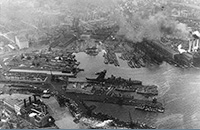Brooklyn Navy Yard
The Brooklyn Navy Yard, also known as The United States Navy Yard, New York and the New York Naval Shipyard, became an active naval installation in 1806. During the years between 1939 and 1945, the shipyard's workforce increased to 70,000 employees, many of whom were women who worked as mechanics and technicians in support of the war effort.

Written by Aaron Munz • Edited By Walter Pacheco
Asbestos.com is the nation’s most trusted mesothelioma resource
The Mesothelioma Center at Asbestos.com has provided patients and their loved ones the most updated and reliable information on mesothelioma and asbestos exposure since 2006.
Our team of Patient Advocates includes a medical doctor, a registered nurse, health services administrators, veterans, VA-accredited Claims Agents, an oncology patient navigator and hospice care expert. Their combined expertise means we help any mesothelioma patient or loved one through every step of their cancer journey.
More than 30 contributors, including mesothelioma doctors, survivors, health care professionals and other experts, have peer-reviewed our website and written unique research-driven articles to ensure you get the highest-quality medical and health information.
About The Mesothelioma Center at Asbestos.com
- Assisting mesothelioma patients and their loved ones since 2006.
- Helps more than 50% of mesothelioma patients diagnosed annually in the U.S.
- A+ rating from the Better Business Bureau.
- 5-star reviewed mesothelioma and support organization.
Testimonials
My family has only the highest compliment for the assistance and support that we received from The Mesothelioma Center. This is a staff of compassionate and knowledgeable individuals who respect what your family is experiencing and who go the extra mile to make an unfortunate diagnosis less stressful. Information and assistance were provided by The Mesothelioma Center at no cost to our family.LashawnMesothelioma patient’s daughter
How to Cite Asbestos.com’s Article
APA
Munz, A. (2023, August 22). Brooklyn Navy Yard. Asbestos.com. Retrieved April 19, 2024, from https://www.asbestos.com/shipyards/brooklyn-navy-yard/
MLA
Munz, Aaron. "Brooklyn Navy Yard." Asbestos.com, 22 Aug 2023, https://www.asbestos.com/shipyards/brooklyn-navy-yard/.
Chicago
Munz, Aaron. "Brooklyn Navy Yard." Asbestos.com. Last modified August 22, 2023. https://www.asbestos.com/shipyards/brooklyn-navy-yard/.
During the time when America was part of World War II, asbestos exposure was common to everyone who worked at the facility. Protective clothing for a foundryman or welder included asbestos leggings, aprons and gloves. Inside the asbestos mixing room, employees mixed magnesia and asbestos fiber for insulation.
In 1966, Secretary of Defense Robert McNamara closed the Brooklyn Navy Yard because it cost too much to keep open. But in 1971, the City of New York reopened it as an industrial park.
In 2021, a review of medical literature looked at the risk of asbestos-related cancer among sailors. It found that sailors from some countries have more than double the risk of developing mesothelioma.
Asbestos Products at Brooklyn Navy Yard’s Shops
The pipe shop onsite at the shipyard used asbestos in the lagging it manufactured. That cloth was then used to act as insulation around hot water and steam pipes in the vessels that were repaired at the shipyard. The boiler shop and the central power plant also used asbestos produced on the premises as insulation.
Exposure wasn’t limited to workers who manufactured products containing the toxic mineral. A 1941 personnel needs analysis noted that 19 different trades handled asbestos. Extending and repairing the boiler shop, central power plant and other areas led to heavy exposure.
Some of these jobs were riskier than others. Boiler workers and insulators were especially at risk of high exposure.
A 2017 study evaluated the risk of mesothelioma among shipyard workers. The workers exposed to a moderate amount of asbestos were about four times more likely to die of mesothelioma.
Safety Measures
People in the pipe shop mixed asbestos with magnesia under a special fan that helped keep the air clean. In 1940, they made the fan bigger to improve conditions. Workers had to roll up their sleeves to prevent asbestos dust accumulation. They used special goggles and wash their skin to make sure they didn’t take asbestos home with them.

Medical Officer Recommends Monitoring Employee Health
In April 1940, the medical officer assigned to the Brooklyn Navy Yard issued a report. It included his own observations of the conditions at the facility and the standards suggested by the U.S. Public Health Service.
In his report the medical officer advised that:
- Sandblasters should receive semi-annual chest X-rays
- All asbestos workers should receive annual chest X-rays in January
- Industrial X-ray and radium workers should receive a bimonthly complete blood analysis
- Pickling plant workers in the coppersmith shop should receive semi-annual chest X-rays
- Slate and red putty workers in the paint shop should receive semi-annual chest X-rays
- Spray painters should receive an annual workup that included a chest X-ray and blood tests
- Brush painters did not need any testing unless they were continuously assigned to working with lead paint.
This medical surveillance program was made effective in May 1940.







